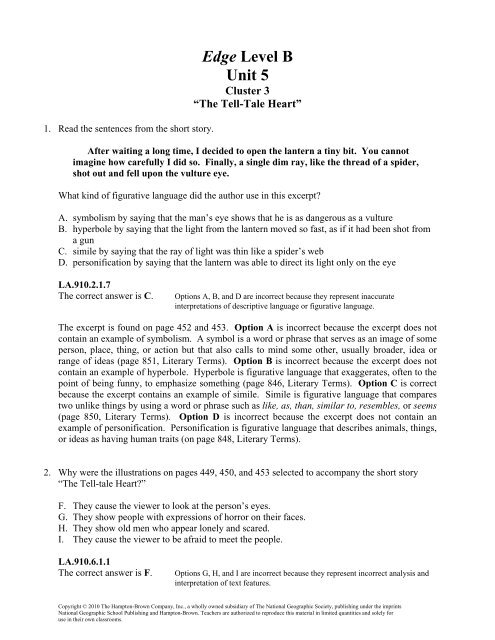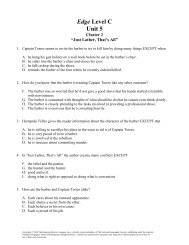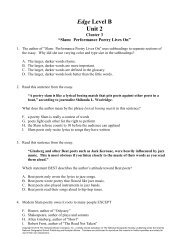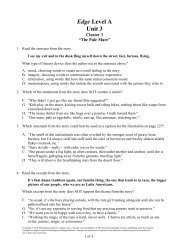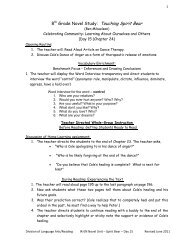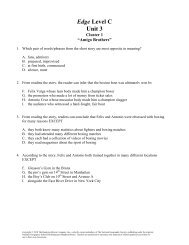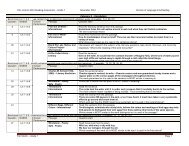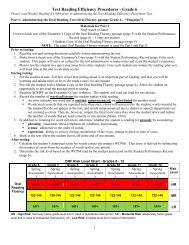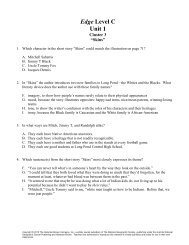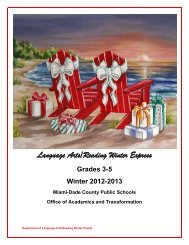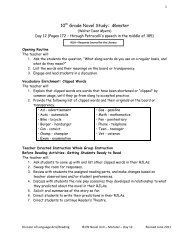Edge Level B Unit 5 - Division of Language Arts/Reading
Edge Level B Unit 5 - Division of Language Arts/Reading
Edge Level B Unit 5 - Division of Language Arts/Reading
You also want an ePaper? Increase the reach of your titles
YUMPU automatically turns print PDFs into web optimized ePapers that Google loves.
1. Read the sentences from the short story.<br />
<strong>Edge</strong> <strong>Level</strong> B<br />
<strong>Unit</strong> 5<br />
Cluster 3<br />
“The Tell-Tale Heart”<br />
After waiting a long time, I decided to open the lantern a tiny bit. You cannot<br />
imagine how carefully I did so. Finally, a single dim ray, like the thread <strong>of</strong> a spider,<br />
shot out and fell upon the vulture eye.<br />
What kind <strong>of</strong> figurative language did the author use in this excerpt?<br />
A. symbolism by saying that the man’s eye shows that he is as dangerous as a vulture<br />
B. hyperbole by saying that the light from the lantern moved so fast, as if it had been shot from<br />
a gun<br />
C. simile by saying that the ray <strong>of</strong> light was thin like a spider’s web<br />
D. personification by saying that the lantern was able to direct its light only on the eye<br />
LA.910.2.1.7<br />
The correct answer is C.<br />
Options A, B, and D are incorrect because they represent inaccurate<br />
interpretations <strong>of</strong> descriptive language or figurative language.<br />
The excerpt is found on page 452 and 453. Option A is incorrect because the excerpt does not<br />
contain an example <strong>of</strong> symbolism. A symbol is a word or phrase that serves as an image <strong>of</strong> some<br />
person, place, thing, or action but that also calls to mind some other, usually broader, idea or<br />
range <strong>of</strong> ideas (page 851, Literary Terms). Option B is incorrect because the excerpt does not<br />
contain an example <strong>of</strong> hyperbole. Hyperbole is figurative language that exaggerates, <strong>of</strong>ten to the<br />
point <strong>of</strong> being funny, to emphasize something (page 846, Literary Terms). Option C is correct<br />
because the excerpt contains an example <strong>of</strong> simile. Simile is figurative language that compares<br />
two unlike things by using a word or phrase such as like, as, than, similar to, resembles, or seems<br />
(page 850, Literary Terms). Option D is incorrect because the excerpt does not contain an<br />
example <strong>of</strong> personification. Personification is figurative language that describes animals, things,<br />
or ideas as having human traits (on page 848, Literary Terms).<br />
2. Why were the illustrations on pages 449, 450, and 453 selected to accompany the short story<br />
“The Tell-tale Heart?”<br />
F. They cause the viewer to look at the person’s eyes.<br />
G. They show people with expressions <strong>of</strong> horror on their faces.<br />
H. They show old men who appear lonely and scared.<br />
I. They cause the viewer to be afraid to meet the people.<br />
LA.910.6.1.1<br />
The correct answer is F.<br />
Options G, H, and I are incorrect because they represent incorrect analysis and<br />
interpretation <strong>of</strong> text features.<br />
Copyright © 2010 The Hampton-Brown Company, Inc., a wholly owned subsidiary <strong>of</strong> The National Geographic Society, publishing under the imprints<br />
National Geographic School Publishing and Hampton-Brown. Teachers are authorized to reproduce this material in limited quantities and solely for<br />
use in their own classrooms.
The illustration by Mark Summers on page 449 shows a person’s face with one side completely<br />
in shadow. The eye on the lighted side <strong>of</strong> the face looks like it is from a sculpture because the<br />
eye has no pupil. The illustration on page 450 is titled “Dying” and is by Theodore Géricault. It<br />
shows the face <strong>of</strong> a man; it is gaunt and distorted. The illustration on page 453 is titled “Head<br />
III” by Francis Bacon. It shows a man’s face, and from his forehead up the face has become part<br />
<strong>of</strong> the background. The eyes, especially the left eye, look right at the viewer. Option F is correct<br />
because each <strong>of</strong> the illustrations seem to draw the viewer’s attention to the eyes <strong>of</strong> the<br />
illustrators’ subjects. Option G is incorrect because none <strong>of</strong> the illustrations’ subjects seem to<br />
be horrified, although they may create a feeling <strong>of</strong> horror in those viewing the illustrations.<br />
Option H is incorrect because not all <strong>of</strong> the people in the illustrations are old. The subject in the<br />
illustration on page 449 does not seem old; there are no wrinkles or obvious signs <strong>of</strong> age. The<br />
man shown in the illustration on page 450, although he looks quite sickly, seems not to be too<br />
old because his hair and beard are not white. The man in the illustration on page 453 does<br />
appear old due to his white beard. Option I is incorrect because not all the subjects seem to be<br />
dangerous or scary. The person shown on page 449 looks like a warrior or adventurer due to the<br />
hat/helmet. The man shown on page 450 looks deathly ill, but not scary. The man shown on<br />
page 453, because only part <strong>of</strong> his head is visible and he seems to be disappearing into the<br />
background, could be considered scary.<br />
3. What technique did Edgar Allen Poe use to develop the plot <strong>of</strong> “The Tell-Tale Heart?”<br />
A. foreshadowing<br />
B. cliffhanger<br />
C. flashback<br />
D. dialogue among characters<br />
LA.910.2.1.5<br />
The correct answer is C.<br />
Options A, B, and D are incorrect because they represent inaccurate<br />
interpretations <strong>of</strong> character, point <strong>of</strong> view, plot development, setting, conflict, or<br />
theme.<br />
Option A is incorrect because the plot is not developed through the use <strong>of</strong> foreshadowing.<br />
Foreshadowing is a hint that a writer gives about an event that will happen later in a story (page<br />
845, Literary Terms). Option B is incorrect because the plot is not developed though the use <strong>of</strong><br />
a cliffhanger. Macmillandictionary.com defines cliffhanger as a situation in which it is not clear<br />
what will happen next. The reader learns at the beginning <strong>of</strong> the story on page 450 that the<br />
narrator has committed murder, “In fact, I was never kinder to him than during the whole week<br />
before I killed him.” Option C is correct because the plot is developed through the use <strong>of</strong> a<br />
flashback. Flashback is an interruption in the action <strong>of</strong> a narrative to tell about something that<br />
happened earlier. It is <strong>of</strong>ten used to give the reader background information about a character or<br />
situation (page 844, Literary Terms). “The Tell-Tale Heart” begins with the narrator telling<br />
about how he feels. Then, in a flashback, he moves into telling about his elaborate planning for<br />
an eventual act <strong>of</strong> murder. Option D is incorrect because the plot is not developed through the<br />
use <strong>of</strong> dialogue among characters. Dialogue is what characters say to each other. Writers use<br />
dialogue to develop characters, move the plot forward, and add interest (page 843, Literary<br />
Terms). The characters in this short story are the narrator, the old man, a neighbor, and three<br />
Hampton Brown <strong>Edge</strong> <strong>Level</strong> B, <strong>Unit</strong> 5, Cluster 3 2 <strong>of</strong> 7
policemen. There is no conversation among the characters. The entire short story is told by the<br />
narrator to the reader.<br />
4. Why did the author give this short story the title “The Tell-Tale Heart?”<br />
F. to show how a younger man’s heart turned cold, leading him to cut out the heart <strong>of</strong> an older<br />
man with whom he lived<br />
G. to reveal to the reader that one’s conscience will not let a person get away with doing<br />
something as horrific as murder<br />
H. to entertain the reader with a story about an insane person who thinks he is sane because he<br />
can make a good plan<br />
I. to tell a tale about the life <strong>of</strong> a young man who cared for an older man for many years until<br />
he died <strong>of</strong> old age<br />
LA.910.1.7.2<br />
The correct answer is G.<br />
Options F, H, and I are incorrect because they represent incorrect interpretations<br />
<strong>of</strong> the author’s purpose or perspective.<br />
Telltale is defined by http://dictionary.reference.com as a thing serving to reveal or disclose<br />
something. Option F is incorrect because the younger man’s heart did not turn cold, he lost is<br />
mind. He did not cut out the heart <strong>of</strong> the older man; he dismembered him as the reader learns on<br />
page 454, “I thought about the best way to hide the body. Then I cut it into pieces. I cut <strong>of</strong>f the<br />
head and the arms and the legs.” Option G is correct because the imagined sounds <strong>of</strong> the old<br />
man’s heart still beating beneath the floor boards, louder and louder, are what made the insane<br />
young man tell the policemen what he had done. As the reader learns on pages 456 and 457, “I<br />
could look at their (the policemen) smiles no longer! I felt that I must scream or die! And now,<br />
again, listen! The sound is louder! Louder! …I admit the deed! Tear up the floor boards! It is<br />
the beating <strong>of</strong> his hideous heart!” Option H is incorrect because the narrator is insane and does<br />
think he is sane because he made a plan. However, this is a major detail in the story, but not the<br />
author’s purpose for writing the story. Option I is incorrect because the man did not die <strong>of</strong> old<br />
age; the younger man suffocated him.<br />
5. The narrator in “The Tell-Tale Heart” tells the reader that he is not insane for many reasons<br />
EXCEPT<br />
A. He figured out the best way to hide the body <strong>of</strong> the old man.<br />
B. He felt that he had an exceptional sense <strong>of</strong> hearing.<br />
C. He did things in a clever and well-planned way.<br />
D. He smiled and welcomed the three police <strong>of</strong>ficers.<br />
LA.910.1.7.3<br />
The correct answer is D.<br />
Options A, B, and C are incorrect because they represent plausible but incorrect<br />
distractors based on the text.<br />
Option A is incorrect because the narrator again reminds the reader <strong>of</strong> his sanity at this point in<br />
the story. As the reader learns on page 454, “If you still think I am mad, you will no longer think<br />
so when I tell you what I did next. I thought about the best way to hide the body. Then I cut it<br />
Hampton Brown <strong>Edge</strong> <strong>Level</strong> B, <strong>Unit</strong> 5, Cluster 3 3 <strong>of</strong> 7
into pieces. I cut <strong>of</strong>f the head and the arms and the legs.” Option B is incorrect because he feels<br />
he is able to hear things very clearly. As the reader learns on page 450, “But why will you say<br />
that I am mad? The disease had made my senses sharper…. Above all, my sense <strong>of</strong> hearing was<br />
sharp. I heard all things in the heaven and in the earth. How, then, can you say I am mad?”<br />
Option C is incorrect because the narrator thinks that the planning and execution <strong>of</strong> the murder<br />
shows his sanity, ignoring the fact that committing the murder may not be considered a sane act.<br />
As the reader learns on page 450, “You think I am mad. But a person who is mad knows<br />
nothing. You should have seen me and how wisely I acted. I was cautious, and I planned<br />
ahead.” Option D is correct because as the narrator relates this part <strong>of</strong> the story, he does not<br />
pr<strong>of</strong>ess his sanity. As the reader learns on page 455, “Three men entered the house. They<br />
introduced themselves as police <strong>of</strong>ficers…. I smiled—for what did I have to fear? I greeted the<br />
<strong>of</strong>ficers warmly.<br />
<strong>Edge</strong> <strong>Level</strong> B<br />
<strong>Unit</strong> 5<br />
Cluster 3<br />
“The Raven”<br />
6. Edgar Allan Poe uses alliteration in many lines EXCEPT<br />
F. line 1: “Once upon a midnight dreary, while I pondered, weak and weary,”<br />
G. line 27: “But the silence was unbroken, and the stillness gave no token,”<br />
H. line 3: “While I sat there, nearly napping, suddenly there came a tapping,”<br />
I. line 37: “Open wide I flung the shutter, when, with many a flit and flutter,”<br />
LA.910.2.1.7<br />
The correct answer is G.<br />
Options F, H, and I are incorrect because they examples <strong>of</strong> descriptive language<br />
or figurative language drawn from the text related to the question being tests.<br />
Alliteration is the repetition <strong>of</strong> the same sounds (usually consonants) at the beginning <strong>of</strong> words<br />
that are close together which is seen with the author’s use <strong>of</strong> pl at the beginning <strong>of</strong> plane and<br />
plopped (page 842, Literary Terms). Option F is incorrect because it contains an example <strong>of</strong><br />
alliteration—the repetition <strong>of</strong> wea at the beginning <strong>of</strong> weak and weary. Option G is correct<br />
because it does not contain an example <strong>of</strong> alliteration. Although two words begin with an s they<br />
make different sounds, /s/ and /st/. Option H is incorrect because it contains an example <strong>of</strong><br />
alliteration—the repetition <strong>of</strong> n at the beginning <strong>of</strong> nearly and napping. Option I is incorrect<br />
because it contains an example <strong>of</strong> alliteration—the repetition <strong>of</strong> fl at the beginning <strong>of</strong> flung, flit,<br />
and flutter.<br />
7. Read the lines from the poem.<br />
But the silence was unbroken, and the stillness gave no token,<br />
And the only word there spoken was the whispered word, “Lenore!”<br />
Hampton Brown <strong>Edge</strong> <strong>Level</strong> B, <strong>Unit</strong> 5, Cluster 3 4 <strong>of</strong> 7
Which word is NOT similar in meaning to token as it is used in this line?<br />
A. sound<br />
B. indication<br />
C. clue<br />
D. sign<br />
LA.910.1.6.8<br />
The correct answer is A.<br />
Options B, C, and D are incorrect because they represent incorrect meanings<br />
(synonyms) <strong>of</strong> the word being assessed.<br />
The excerpt is lines 27 and 28. The Web site mw4.m-w.com/dictionary defines token as an<br />
outward sign or expression. Option A is correct because it is not similar in meaning to the<br />
word being assessed. Sound is defined by macmillandictionary.com as something that you can<br />
hear. Option B is incorrect because it is similar in meaning to the assessed word. Indication is<br />
defined by macmillandictionary.com as a sign that something will happen, is true, or exists.<br />
Option C is incorrect because it is similar in meaning to the word being assessed. Clue is<br />
defined by macmillandictionary.com as a piece <strong>of</strong> information that helps explain a situation or<br />
provide a solution to a problem. Option D is incorrect because it is similar in meaning to the<br />
word being assessed. Sign is defined by macmillandictionary.com as a piece <strong>of</strong> evidence that<br />
something is happening or that something exists.<br />
8. Which illustration that accompanies “The Tell-Tale Heart” could also be used with “The<br />
Raven?”<br />
F. the illustration on page 455<br />
G. the illustration on page 453<br />
H. the illustration on page 449<br />
I. the illustration on page 456<br />
LA.910.6.1.1<br />
The correct answer is H.<br />
Options F, G, and I are incorrect because they represent incorrect analysis and<br />
interpretation <strong>of</strong> text features.<br />
Option F is incorrect because it does not agree with the content <strong>of</strong> “The Raven.” As the reader<br />
learns on page 463 in line 68 a chair is referenced in the poem, “Soon I wheeled a cushioned seat<br />
in front <strong>of</strong> bird and bust and door. However, on page 463 in lines 75-77 the reader learns more<br />
about the appearance <strong>of</strong> the chair which does not match the chair pictured in the illustration, “…I<br />
sat divining, with my head at ease reclining / On the cushion’s velvet lining which the lamp-light<br />
shining…” The chair in the illustration does not have a cushion on its back. Option G is<br />
incorrect because it does not agree with the content <strong>of</strong> “The Raven.” Although the reader does<br />
not know the age <strong>of</strong> the man who narrates “The Raven,” the reader does know that there is light<br />
in the bedroom where the poem is set. In the illustration the man is becoming part <strong>of</strong> his dark<br />
background, and this is not what happens in “The Raven.” Option H is correct because it does<br />
agree with the content <strong>of</strong> “The Raven.” This illustration is most likely a statue <strong>of</strong> the Greek<br />
goddess, Athena, known as Pallas in “The Raven.” In the illustration the bird, a raven, in<br />
perched on her head as the reader learns on page 461, lines 38 and 41, “In there stepped a noble<br />
Hampton Brown <strong>Edge</strong> <strong>Level</strong> B, <strong>Unit</strong> 5, Cluster 3 5 <strong>of</strong> 7
Raven from the ancient days <strong>of</strong> yore….Perched upon a bust <strong>of</strong> Pallas just above my bedroom<br />
door…” Option I is incorrect because it does not agree with the content <strong>of</strong> “The Raven.” It<br />
shows a person who is suffering greatly in agony. Although the narrator in “The Raven” is<br />
mourning for Lenore, Poe does not tell the reader that he is suffering to the degree shown in the<br />
illustration.<br />
9. Read the stanza from the poem.<br />
So I sat engaged in guessing, but without a word expressing<br />
To the bird whose fiery eyes now burned into my spirit’s core;<br />
This and more I sat divining, with my head at ease reclining<br />
On the cushion’s velvet lining which the lamp-light shined all over,<br />
But whose velvet violet lining with the lamp-light shining o’er,<br />
She shall touch, ah, nevermore!<br />
What form <strong>of</strong> figurative language does Poe use in these lines?<br />
A. symbolism by comparing his love to a cushion<br />
B. pun by using divining and guessing to mean the same thing<br />
C. personification by portraying a bird as someone with which to have a conversation<br />
D. metaphor by comparing the gaze <strong>of</strong> the Raven to a fire<br />
LA.910.2.1.7<br />
The correct answer is D.<br />
Options A, B, and C are incorrect because they represent inaccurate<br />
interpretations <strong>of</strong> descriptive language or figurative language.<br />
This stanza is found on page 463 and includes lines 73-78. Option A is incorrect because the<br />
excerpt does not contain an example <strong>of</strong> symbolism. A symbol is a word or phrase that serves as<br />
an image <strong>of</strong> some person, place, thing, or action but that also calls to mind some other, usually<br />
broader, idea or range <strong>of</strong> ideas (page 851, Literary Terms). Option B is incorrect because the<br />
excerpt does not contain an example <strong>of</strong> a pun. A pun is an expression, used for emphasis or<br />
humor, in which two distinct meanings are suggested by one word or by two similar-sounding<br />
words (page 849, Literary Terms). Option C is incorrect because the excerpt does not contain<br />
an example <strong>of</strong> personification. Personification is figurative language that describes animals,<br />
things, or ideas as having human traits (on page 848, Literary Terms). Option D is correct<br />
because the excerpt contains an example metaphor. Metaphor is a type <strong>of</strong> figurative language<br />
that compares two unlike things by saying that one thing is the other thing (page 847, Literary<br />
Terms).<br />
10. The short story “The Tell-Tale Heart” and the poem “The Raven” are similar in many ways<br />
EXCEPT<br />
F. The narrators both show signs <strong>of</strong> insanity.<br />
G. Both works focus on death.<br />
H. Sound plays a pivotal role in each work.<br />
I. The narrators are both mourning the death <strong>of</strong> someone dear to them.<br />
Hampton Brown <strong>Edge</strong> <strong>Level</strong> B, <strong>Unit</strong> 5, Cluster 3 6 <strong>of</strong> 7
LA.910.1.7.7<br />
The correct answer is I.<br />
Options F, G, and H are incorrect because they represent correct comparisons.<br />
Option F is incorrect because neither narrator behaves in a sane manner. The narrator in “The<br />
Tell-Tale Heart” spends a great deal <strong>of</strong> time trying to convince the reader that he is sane while he<br />
behaves in an abnormal way. The narrator in “The Raven” tries to have a conversation with a<br />
large bird who answers every question with the same word, “Nevermore.” Option G is incorrect<br />
because both works do focus on death. “The Tell-Tale Heart” is about the murder <strong>of</strong> an old man<br />
and the thoughts and actions <strong>of</strong> his murderer; “The Raven” is built around the death <strong>of</strong> Lenore<br />
and the mourning <strong>of</strong> the narrator for her. Option H is incorrect because sound is important to<br />
both works. In “The Tell-Tale Heart” the narrator thinks the sound <strong>of</strong> the dead man’s beating<br />
heart must be heard by the police <strong>of</strong>ficers and so he confesses to the murder. In “The Raven” the<br />
narrator hears a tapping at his door, but no one is there. The tapping is heard again at the<br />
window, and, when it is opened, the Raven enters the bedroom. Option I is correct because both<br />
narrators are affected by the death <strong>of</strong> someone near to them; however, only the narrator <strong>of</strong> “The<br />
Raven” is in mourning. As the reader learns on page 455 the narrator is almost happy, “I<br />
smiled—for what did I have to fear? I greeted the <strong>of</strong>ficers warmly…The <strong>of</strong>ficers believed me. I<br />
was at ease. They sat there for a while, chatting about everyday things.” However, in “The<br />
Raven” the narrator is in mourning. As the reader learns on page 459, lines 9-11, “…I had tried<br />
but failed to borrow / Help from books to cease my sorrow—sorrow for the lost Lenore…”<br />
Hampton Brown <strong>Edge</strong> <strong>Level</strong> B, <strong>Unit</strong> 5, Cluster 3 7 <strong>of</strong> 7


